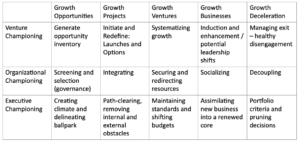
Leading strategic growth and change doesn’t need to be a mystery! If only we taught people the skills necessary for three key leadership roles, it could be a lot more systematic and corporate transformation efforts might yield a lot more success.

The anatomy of a successful growth pipeline.
The first thing to realize about managing a pipeline for innovation and growth is that it implies that you will have many initiatives in different stages, all at the same time. Different companies call these stages different things, but I’ll argue that you need at least the following five types of projects.
- Growth opportunities: These are often just ideas that have not yet found a home. You do want to ensure a steady flow of them, which implies some slack resources that are available for people who would like to try new things out. Ideas can come from anywhere, so make sure that everyone knows theirs are welcome.
- Growth projects: These are the projects that people are actively working on. It could be part time, it could be small scale, but they are in pursuit of finding that magical chemistry between what your organization can offer and what a willing buyer in a market might want.
- Growth ventures: At this stage, a project typically will have a dedicated team, dedicated resources and a pretty strong hypothesis about customer demand. Toward the end of this stage, there are happy, paying customers, the economics of the venture have come into focus and we can now start talking about incorporating the venture as part of our future core business.
- Growth businesses: Show time! This is when the amount of uncertainty in a business has been reduced, its operations are more predictable, and it can safely become part of the “mother-ship.” This stage is like a phase change, with maturing technical, organizational and functional units all taking their role.
- Growth deceleration: Of course, most venture ideas will never become big businesses. And even the most carefully tended big business is likely to erode eventually, as markets, technology and competition changes. This part of the lifecycle involves stopping things – which you can think of as disengagement. What you want is for that process to be as healthy as possible.
To manage these well, there are at least 3 different levels of leadership challenges. These can be individuals or more likely multiple individuals engaged in systematic innovation-supporting activities.
Executive Championing: The Executive Champion is broadly responsible for the role of innovation and entrepreneurship within the context of a broader strategy. The single most important act an executive champion can engage in is to continuously devote disproportionate time to the new ventures – like a toddler’s head, ventures need more resources relative to their size, than the core business. The next most important thing is to put the very best talent on new ventures – if ventures become the place where your career goes to die, it will never be a priority. Finally, executive champions are often venturing’s most important spokesperson to external ecosystem partners and other supporters (such as the investing community).
Organizational Championing: The organizational champion is someone we affectionately call a “sherpa.” Like the sherpas who will guide you up Mount Everest, the organizational version acts as a buffer between the venture and the “mothership,” making sure that the venture isn’t suffocated but also that the mothership’s interests (reputation, budgets, people) are served as well. This is the invisible, but often ignored, critical role behind entrepreneurial ventures.
Venture Championing: Venture champions are those who are immediately responsible for building the business. There may be several such champions on any given venturing team, depending on the skills required. Venture champions are responsible for defining product/market fit, figuring out feasibility, market desirability and economic desirability. Venture champions manage via discovery driven development – planning to the next checkpoint and making decisions as new information is uncovered. Venture champions are the closest thing a corporation has to an internal entrepreneur. They work continuously with the organizational champion and the growth board but are also very intentional about getting feedback externally. As Steve Blank likes to say, “there are no answers in the building.”
This yields the following framework:

So, are you missing a key role or activity? Consider these questions, each related to the framework.

Of the 15 questions, if you’re answering “no” to 5 or more, it means you have serious holes in your strategic growth and change processes. It means that today’s business is dominating tomorrow’s. And it means that you might inadvertently be setting yourself up for irrelevance as business changes around us.
Valize was set up to enable organizations to tackle challenges companies face in mastering their futures. Check out our web page and be in touch if any of this resonates.
